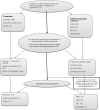The yield of community-based tuberculosis and HIV among key populations in hotspot settings of Ethiopia: A cross-sectional implementation study
- PMID: 32469997
- PMCID: PMC7259557
- DOI: 10.1371/journal.pone.0233730
The yield of community-based tuberculosis and HIV among key populations in hotspot settings of Ethiopia: A cross-sectional implementation study
Abstract
Objective: To determine the yield of tuberculosis (TB) and the prevalence of Human Immuno-deficiency virus (HIV) among key populations in the selected hotspot towns of Ethiopia.
Methods: We undertook a cross-sectional implementation research during August 2017-January 2018. Trained TB focal persons and health extension workers (HEWs) identified female sex workers (FSWs), health care workers (HCWs), prison inmates, homeless, internally displaced people (IDPs), internal migratory workers (IMWs) and residents in missionary charities as key and vulnerable popuaiton. They carried out health education on the importance of TB screening and HIV testing prior to recruitment of the study participants. Symptomatic TB screening and HIV testing was done. The yield of TB was computed per 100,000 background key population.
Results: A total of 1878 vulnerable people were screened, out of which 726 (38.7%) presumptive TB cases and 87 (4.6%) TB cases were identified. The yield of TB was 1519 (95% CI: 1218.1-1869.9). The highest proportion (19.5%) and yield of TB case (6,286 (95% CI: 3980.8-9362.3)) was among HCWs. The prevalence of HIV infection was 6%, 67 out of 1,111 tested. IMWs and FSWs represented 49.3% (33) and 28.4% (13) of the HIV infections, respectively. There was a statistically significant association of active TB cases with previous history of TB (Adjusted Odds Ratio (AOR): 11 95% CI, 4.06-29.81), HIV infection (AOR: 7.7 95% CI, 2.24-26.40), and being a HCW (AOR: 2.42 95% CI, 1.09-5.34).
Conclusions: The prevalence of TB in key populations was nine times higher than 164/100,000 national estimated prevalence rate. The prevalence of HIV was five times higher than 1.15% of the national survey. The highest yield of TB was among the HCWs and the high HIV burden was detected among the FSWs and IMWs. These suggest a community and health facility based integrated and enhanced case finding approaches for TB and HIV in hotspot settings.
Conflict of interest statement
The authors have declared that no competing interests exist.
Figures

Similar articles
-
Prevalence of pulmonary tuberculosis among key and vulnerable populations in hotspot settings of Ethiopia. A systematic review and meta-analysis.PLoS One. 2024 Aug 29;19(8):e0309445. doi: 10.1371/journal.pone.0309445. eCollection 2024. PLoS One. 2024. PMID: 39208068 Free PMC article.
-
Prevalence of pulmonary tuberculosis and its associated factors among people who ecprience homelessness living in selected towns in Wolaita zone, southern Ethiopia.J Health Popul Nutr. 2025 Apr 21;44(1):130. doi: 10.1186/s41043-025-00870-x. J Health Popul Nutr. 2025. PMID: 40259425 Free PMC article.
-
Prevalence of smear positive pulmonary tuberculosis among prisoners in North Gondar Zone Prison, northwest Ethiopia.BMC Infect Dis. 2012 Dec 15;12:352. doi: 10.1186/1471-2334-12-352. BMC Infect Dis. 2012. PMID: 23241368 Free PMC article.
-
Smear positive pulmonary tuberculosis and HIV co-infection in prison settings of North Gondar Zone, Northwest Ethiopia.BMC Public Health. 2016 Oct 18;16(1):1091. doi: 10.1186/s12889-016-3761-y. BMC Public Health. 2016. PMID: 27756279 Free PMC article.
-
Effectiveness of service models and organisational structures supporting tuberculosis identification and management in hard-to-reach populations in countries of low and medium tuberculosis incidence: a systematic review.BMJ Open. 2018 Sep 8;8(9):e019642. doi: 10.1136/bmjopen-2017-019642. BMJ Open. 2018. PMID: 30196265 Free PMC article.
Cited by
-
A retrospective study of tuberculosis prevalence and associated factors among HIV-positive key populations in Nigeria.PLOS Glob Public Health. 2024 Jul 12;4(7):e0003461. doi: 10.1371/journal.pgph.0003461. eCollection 2024. PLOS Glob Public Health. 2024. PMID: 38995935 Free PMC article.
-
Effect of multicomponent interventions on tuberculosis notification in mining and pastoralist districts of Oromia region in Ethiopia: a longitudinal quasi-experimental study.BMJ Open. 2023 May 15;13(5):e071014. doi: 10.1136/bmjopen-2022-071014. BMJ Open. 2023. PMID: 37188473 Free PMC article.
-
Burden of tuberculosis among vulnerable populations worldwide: an overview of systematic reviews.Lancet Infect Dis. 2023 Dec;23(12):1395-1407. doi: 10.1016/S1473-3099(23)00372-9. Epub 2023 Sep 8. Lancet Infect Dis. 2023. PMID: 37696278 Free PMC article. Review.
-
Prevalence of pulmonary tuberculosis among key and vulnerable populations in hotspot settings of Ethiopia. A systematic review and meta-analysis.PLoS One. 2024 Aug 29;19(8):e0309445. doi: 10.1371/journal.pone.0309445. eCollection 2024. PLoS One. 2024. PMID: 39208068 Free PMC article.
-
Thinking fast and slow: the urgency of crisis response must not lead us to overlook chronic needs such as tuberculosis.BMJ Glob Health. 2025 Mar 25;10(3):e018012. doi: 10.1136/bmjgh-2024-018012. BMJ Glob Health. 2025. PMID: 40132810 Free PMC article. No abstract available.
References
-
- World Health Organization (WHO). Global tuberculosis report 2015. Geneva: WHO; 2015 [cited 2019 May 29]. 192 p. https://apps.who.int/iris/bitstream/handle/10665/191102/9789241565059_en...
-
- WHO. Towards tuberculosis elimination: An action framework for low-incidence countries. Geneva: WHO; 2014 [cited 2019 May 29]. 67 p. https://apps.who.int/iris/bitstream/handle/10665/132231/9789241507707_en...
-
- WHO. Global tuberculosis report 2018. Geneva: WHO; 2018 [cited 2019 May 29]. 265 p. https://www.who.int/tb/publications/global_report/en/.
-
- Stop TB partnership. 90-(90)-90 progress report of the Global Plan to End TB 2016–2020. Geneva: WHO; 2017 [cited 2019 June 18]. http://www.stoptb.org/news/stories/2017/ns17_060.asp
-
- National Tuberculosis control program. National operation guide on TB key affected populations in Ethiopia and implementation plan 2018–2020. Addis Ababa, FMOH; September 2017
Publication types
MeSH terms
LinkOut - more resources
Full Text Sources
Medical

